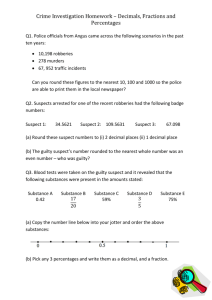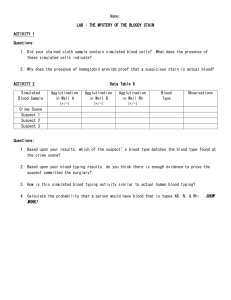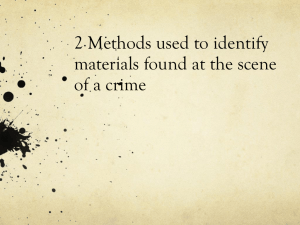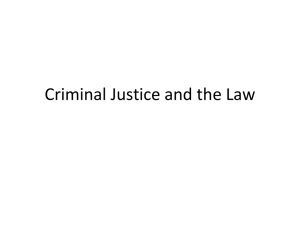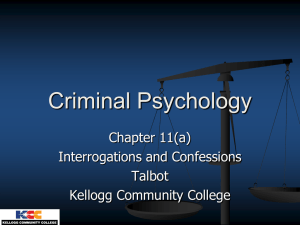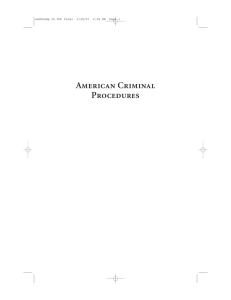Due Process and Exclusionary Rule Concepts of Criminal Law
advertisement
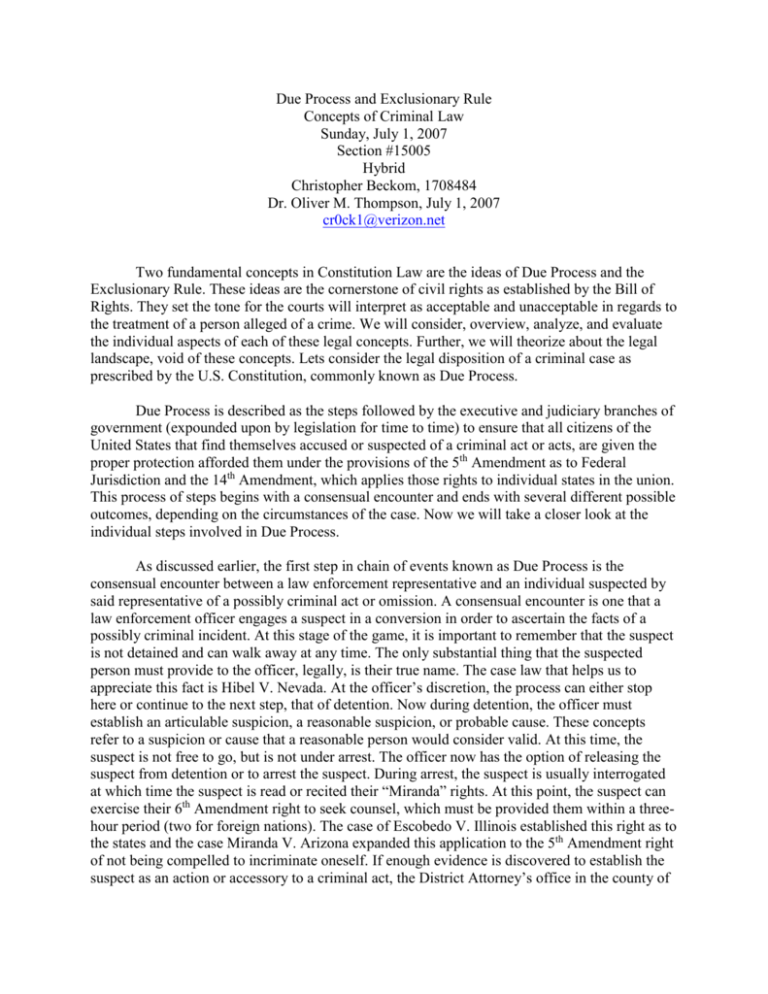
Due Process and Exclusionary Rule Concepts of Criminal Law Sunday, July 1, 2007 Section #15005 Hybrid Christopher Beckom, 1708484 Dr. Oliver M. Thompson, July 1, 2007 cr0ck1@verizon.net Two fundamental concepts in Constitution Law are the ideas of Due Process and the Exclusionary Rule. These ideas are the cornerstone of civil rights as established by the Bill of Rights. They set the tone for the courts will interpret as acceptable and unacceptable in regards to the treatment of a person alleged of a crime. We will consider, overview, analyze, and evaluate the individual aspects of each of these legal concepts. Further, we will theorize about the legal landscape, void of these concepts. Lets consider the legal disposition of a criminal case as prescribed by the U.S. Constitution, commonly known as Due Process. Due Process is described as the steps followed by the executive and judiciary branches of government (expounded upon by legislation for time to time) to ensure that all citizens of the United States that find themselves accused or suspected of a criminal act or acts, are given the proper protection afforded them under the provisions of the 5th Amendment as to Federal Jurisdiction and the 14th Amendment, which applies those rights to individual states in the union. This process of steps begins with a consensual encounter and ends with several different possible outcomes, depending on the circumstances of the case. Now we will take a closer look at the individual steps involved in Due Process. As discussed earlier, the first step in chain of events known as Due Process is the consensual encounter between a law enforcement representative and an individual suspected by said representative of a possibly criminal act or omission. A consensual encounter is one that a law enforcement officer engages a suspect in a conversion in order to ascertain the facts of a possibly criminal incident. At this stage of the game, it is important to remember that the suspect is not detained and can walk away at any time. The only substantial thing that the suspected person must provide to the officer, legally, is their true name. The case law that helps us to appreciate this fact is Hibel V. Nevada. At the officer’s discretion, the process can either stop here or continue to the next step, that of detention. Now during detention, the officer must establish an articulable suspicion, a reasonable suspicion, or probable cause. These concepts refer to a suspicion or cause that a reasonable person would consider valid. At this time, the suspect is not free to go, but is not under arrest. The officer now has the option of releasing the suspect from detention or to arrest the suspect. During arrest, the suspect is usually interrogated at which time the suspect is read or recited their “Miranda” rights. At this point, the suspect can exercise their 6th Amendment right to seek counsel, which must be provided them within a threehour period (two for foreign nations). The case of Escobedo V. Illinois established this right as to the states and the case Miranda V. Arizona expanded this application to the 5th Amendment right of not being compelled to incriminate oneself. If enough evidence is discovered to establish the suspect as an action or accessory to a criminal act, the District Attorney’s office in the county of the crime’s commission, has the option of bringing a formal complaint against the suspect, whether that is a felony or misdemeanor complaint, to the court of proper jurisdiction. At which point the suspect is arraigned before the judicial officer designated to hear that particular matter. The suspect must be arraigned within 48 hours of the arrest, barring weekends and holidays. During the arraignment the suspect is given the opportunity to enter a “plea” or state whether he or she is guilty, not guilty, not guilty by reason of insanity, or nolo contendere or no contest. After the arraignment, the suspect is given a preliminary hearing, in which the determination is made as to whether the suspect should be “held to answer” at trial or released and charges dismissed, generally without prejudice. If it is determined by a judicial officer or jury that the “defendant” should be held to answer, then preparations are made to go to trial. Before trial, any pre-trial motions are made by the prosecution and the defensive attorney, establishing the parameters by which the arguments and evidence are to be presented during the course of the trial. The Next step in the Due Process model is the trial phase. During this period argument, evidence, and testimony is heard from both the defense and the prosecution and then, if charges are not summarily dismissed, the trial goes to the deliberation phase. At the deliberation phase, the judicial officer or the jury considers all evidence, arguments, and testimony heard during trial and comes up with a “verdict” or decision of whether he or she, speaking of the judicial officer, or they collectively, speaking of a jury of 12, have found merit to convict the defendant or, due to lack of establishment of a “beyond a reasonable doubt” burden of proof, have chosen to acquit or dismiss the charges against the defendant. If the jury cannot come to a 12-0 verdict then we have a “hung” jury and a mistrial is declared, at which point the District Attorney either can re file charges or choose to dismiss the matter. If a guilty verdict is reached, then the sentencing a phase commences and the sentence is given to the guilty party, according to statute and judicial officer’s discretion. This sentencing can include imprisonment, probation, or diversion. Subsequently, if imprisonment is the outcome of sentencing, parole may be made available to the incarcerated individual. Furthermore, if an individual is convicted of certain category of crime, e.g., Sexual Assault, Gang Activity, etc. That individual, in connection with proposition 83, must register with the local law enforcement agency’s office in the city or town in which they reside for the rest of their lives. Now that we have analyzed and evaluated the complete chain of events involved in the Due Process model of criminal case adjudication, lets look at the exclusionary rule as it related to the Criminal Law process. When we speak of “exclusionary rule” we speak of the statutes and case law that combine to help paint an accurate picture of how the courts will interpret the actions of law enforcement investigators in the accumulation of evidence and facts that will lead to the conviction of an individual versus the rights afforded them by the 4th, 5th, and 6th Amendments respectively. Case law on this matter include Wolf V. Colorado, Escobedo V. Illinois, Miranda V. Arizona, Mapp V. Ohio and Dickerson V. U.S., that provide the legal precedence that guide the judicial officer’s analysis of a given situation. For instance, if a defendant in some matter claims that they were not furnished with the opportunity to seek counsel after a reasonable period of time after their arrest and custodial interrogation, and were subsequently unduly coerced into giving a confession, perhaps the judicial officer will look at the cases of Escobedo V. Illinois, Miranda V. Arizona, and Dickerson V. U.S., to get direction on how he or she should rule as to admissibility in the given scenario. This concept of “Stare Decisis,” or to stand by things settled, is the legal concept by which precedence is set. Furthermore, the exclusionary rule gives birth to the concept of the doctrine of “Fruit of the Poisonous Tree” in which if the actions of law enforcement start or are grounded, as it was, in unconstitutional actions (minus the good faith exception), then all subsequent actions are deemed to be inadmissible. The Case law precedence here is the case of Wong Sun V. U.S. Therefore, we have reached an analysis, evaluation, and overview of Due Process and Exclusionary Rule. Now, we will theorize on the criminal law landscape devoid of these rights. Imagine if you will, that you are stopped by law enforcement, with no probable cause and immediately throw into prison for several months, with no communication with the outside world. After this time has lapsed, you are sentenced by a judge, absent of legal counsel mind you, to 20 years of further imprisonment for a crime in which you did not commit and based on circumstances of which you were not made aware. Evidence was collected against you in a manner that was not brought to your attention and a fraudulent confession was concocted with your name on it! Sound scary, well this and similar circumstances have existed in this country at one time and still exist in others! That is why it is paramount to understand and properly apply legal concepts like the Due Process model and the exclusionary rule; for these are the foundation of civil rights of U.S. citizens and foreign nationals, in regards the criminal legal process in this country. Thus, it is necessary to carry on the tradition of legal education and training on these and other cornerstone ideologies that compose the American Jurisprudence.

